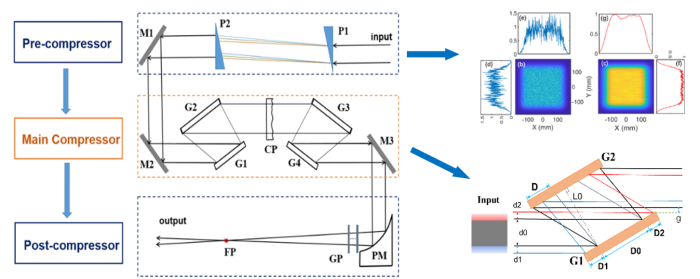In a recent study, scientists at Shanghai Institute of Optics and Fine Mechanics, Chinese Academy of Sciences, designed a new “multistep pulse compressor(MPC)” for 10s-100s PW lasers. This work had been published in Optics Express on 19 May, 2021.
Petawatt (PW) laser pulses have opened up many important research fields in ultrahigh intensity physics, such as particle acceleration and nonlinear QED. One of the most significant bottlenecks in achieving 10s-100s PW lasers is the limited size and damage threshold of compression gratings. In the 100s PW laser designs of ELI and XCELS, about ten pulse compressors together with tiled-aperture beam-combining were used, which made the system complex, high cost, and difficult to achieve.
In 2020, a new in-house beam-splitting compressor based on the property that the damage threshold of gratings depends on the pulse duration was proposed to simultaneously improve the stability, save on expensive gratings, and simplify compressor size [Optics Express 28(15):22978(2020)].
Here, Prof. Jun Liu and his cooperators propose a novel MPC design considering both the temporal and the spatial properties. The idea is the same as chirped pulse amplification (CPA) method which obtained the 2018 Nobel Prize in Physics, as shown in Fig.1. The CPA method was proposed to solve the damage problem of laser crystal during improving the laser peak power in 1985 [Opt. Commun., 55(6):447(1985)].
In the CPA method, the damage problem of laser crystal is transferred to the laser pulse in the temporal domain to achieve the highest input/output laser energy, and then a pulse stretcher and a pulse compressor are designedly added before and after the laser amplifier, respectively, to solve the induced laser pulse duration issues. The proposed MPC method here is to solve the damage problem of compression gratings during enhancing the laser peak power to extremely high 100s PW level. The damage problems of gratings are transferred to the spatiotemporal properties to achieve the highest input/output pulse energy in the main four-grating compressor (FGC).
Then, a designed pre-compressor and a designed post-compressor are added before and after the FGC, respectively, to solve the induced spatiotemporal problems, as shown in Fig. 2. With this novel design, as high as 100 PW laser with single beam or more than 150 PW through combining two beams can be obtained by using currently available optics, which is simple, low cost, and together with improved laser stability in comparison to previous designs of 100s PW lasers.
This MPC design not only can be used in the SEL-100PW laser system, but also in all other PW laser facilities to improve the peak power and reduce the operation damage risk of gratings. Several 100s PW laser beam is expected to be obtained by using this MPC method in the future, which will further extend the ultra-intense laser physics research fields.
This research was supported by the National Natural Science Foundation of China, the Instrument Developing Project and the Strategic Priority Research Program of the Chinese Academy of Sciences, and Shanghai Municipal Science and Technology Major Project.

Fig.1 The comparison of CPA and MPC methods. (Image by SIOM)

Fig.2 The principle of MPC. (Image by SIOM)
Article website:
https://doi.org/10.1364/OE.424356
Contact:
WU Xiufeng
General Administrative Office
Shanghai Institute of Optics and Fine Mechanics, CAS
Email: xfwu@siom.ac.cn
Web: http://english.siom.cas.cn/